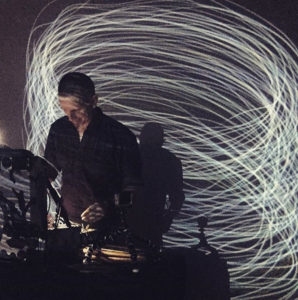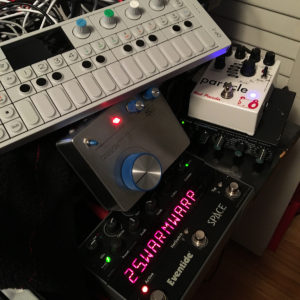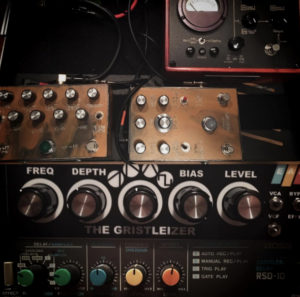My latest full-length album, Deceiver, is available today as a digital download and limited-edition CD (100 copies, signed and numbered). This completes my “Form Cycle” trilogy of full-length albums that began last year (2015), a two-year period of writing, performing, and mixing. I thought I’d share some notes on how the album came together…and use this as an opportunity to go into more details on what’s coming in the future.
Background

Being trained as an artist, I was always taught to spin up multiple projects at once so if I ground down to a standstill on one, I could turn that canvas to the wall and shift to something different. Drifter was so ethereal that I started making more visceral tracks as a counterbalance, to have breaks in order to stay fresh. After exploring where these emotions and feelings came from, a theme quickly emerged, and more work spilled forth, and the final piece of this three-part puzzle locked into place.
I do think of these tracks as collections, unified pieces of work that last about an hour in length. I don’t mandate that people listen to them as such, but they’re specifically crafted to reward end-to-end listening. If that makes me an odd man out in the 21st Century, so be it. It keeps me more mindful about the pieces on the album, and I think it benefits from this approach, even if others don’t see it that way.
It’s also not a complete coincidence that this album was announced the morning after the 2016 US Election.
Themes
If the Dissolver album explored forms falling apart, and Drifter explored being formless, then I’m just going ask you to engage with Deceiver, the work that preceded it, and see where it takes you.
Technique and Instruments
 The first challenge I set for myself was to relax the duration of my tracks. The other two albums in the trilogy had few tracks over four minutes in length. Here, I wanted to let things stretch out, build, unwind, and evolve, and even let motifs and ideas span tracks. In addition, the pieces of many tracks (and a few entire tracks themselves) were played live in the studio, largely as a result of having started playing modular synthesizers live after the release of Drifter, and some of that looseness was left into the final tracks.
The first challenge I set for myself was to relax the duration of my tracks. The other two albums in the trilogy had few tracks over four minutes in length. Here, I wanted to let things stretch out, build, unwind, and evolve, and even let motifs and ideas span tracks. In addition, the pieces of many tracks (and a few entire tracks themselves) were played live in the studio, largely as a result of having started playing modular synthesizers live after the release of Drifter, and some of that looseness was left into the final tracks.
I knew from the outset this album would be more beat-oriented, and so the rhythmic components were critical. After a lot of experimentation, I settled on two main drum systems: a vintage Roland TR-606 and a Eurorack modular drum kit, synced together and sending triggers to each other. The modular drum kit changed throughout the recording sessions, but the one-of-a-kind BugBrand DRM1 that I had customized to the Eurorack format provides most of the kick drums on the album. The drums were played by hand, traditionally sequenced, and probability-driven, in various combinations. An Acidlab Miami (an analog TR-808 clone) was used a little bit for higher-frequency details and fills.
 This album also features a lot of distortion and saturation. The key elements there included Industrialectric pedals, a Retro Mechanical Devices Trouble Shooter (discontinued with both Silicon and Germanium circuits), modular wave folders, the Endangered Audio Research Gristleizer, overdriven cassette tape, and the classic Sound Toys Decapitator plug-in.
This album also features a lot of distortion and saturation. The key elements there included Industrialectric pedals, a Retro Mechanical Devices Trouble Shooter (discontinued with both Silicon and Germanium circuits), modular wave folders, the Endangered Audio Research Gristleizer, overdriven cassette tape, and the classic Sound Toys Decapitator plug-in.
This is the only album in the trilogy that doesn’t feature any guitar source material, and which contains the least amount of piano material. It continues to heavily feature Eurorack modular synthesizers, Ciat Lonbarde instruments, the Teenage Engineering OP-1, and field recordings. The tracks Vinash Purush and The Devil You Know feature the Rare Waves Grendel Drone Commander heavily.
 One notable field recording session included a battery-powered hand massager placed on the roof of a rickety aluminum shed; it had an utterly apocalyptic tone that was too good to pass up; that appears in Vinash Purush. Samplr for iOS has remained the only consistent software instrument to be featured on all three albums in the trilogy. Almost every track has one instrument that’s unique to it, including the Landscape HC-TT (human controlled tape transport), a Bleep Labs Nebulophone, circuit bent toys from Error Instruments, and a Stylophone Beat Box.
One notable field recording session included a battery-powered hand massager placed on the roof of a rickety aluminum shed; it had an utterly apocalyptic tone that was too good to pass up; that appears in Vinash Purush. Samplr for iOS has remained the only consistent software instrument to be featured on all three albums in the trilogy. Almost every track has one instrument that’s unique to it, including the Landscape HC-TT (human controlled tape transport), a Bleep Labs Nebulophone, circuit bent toys from Error Instruments, and a Stylophone Beat Box.
What Comes Next
This cycle is over. No more alliterative album names or circular motifs. What’s next?
I’ve been performing live more frequently, and as a result more improvisational playing is starting to integrate nicely with generative sequencing and composition techniques to create some new and exciting material. I can guarantee that some new releases will take my work in some new directions in 2017.
In the meantime, sketches from my studio will always be posted to Soundcloud or Instagram, and any new project or release announcements can be found on Twitter or music.noisejockey.net. You can also reluctantly find me on Facebook.
Thanks for reading, and for coming on this journey with me. There’s so much more to come.